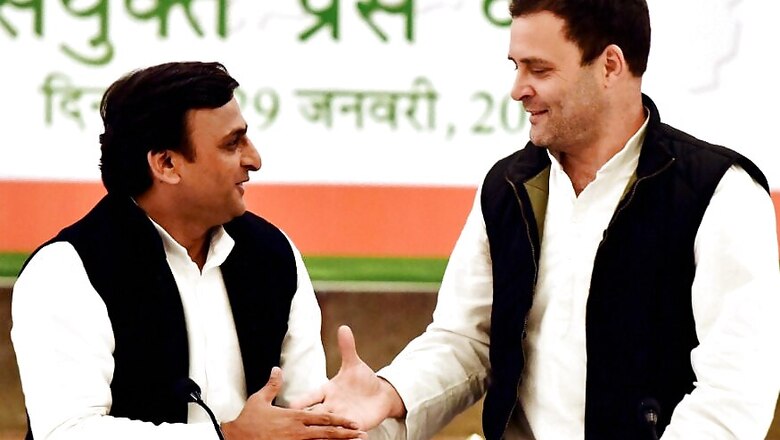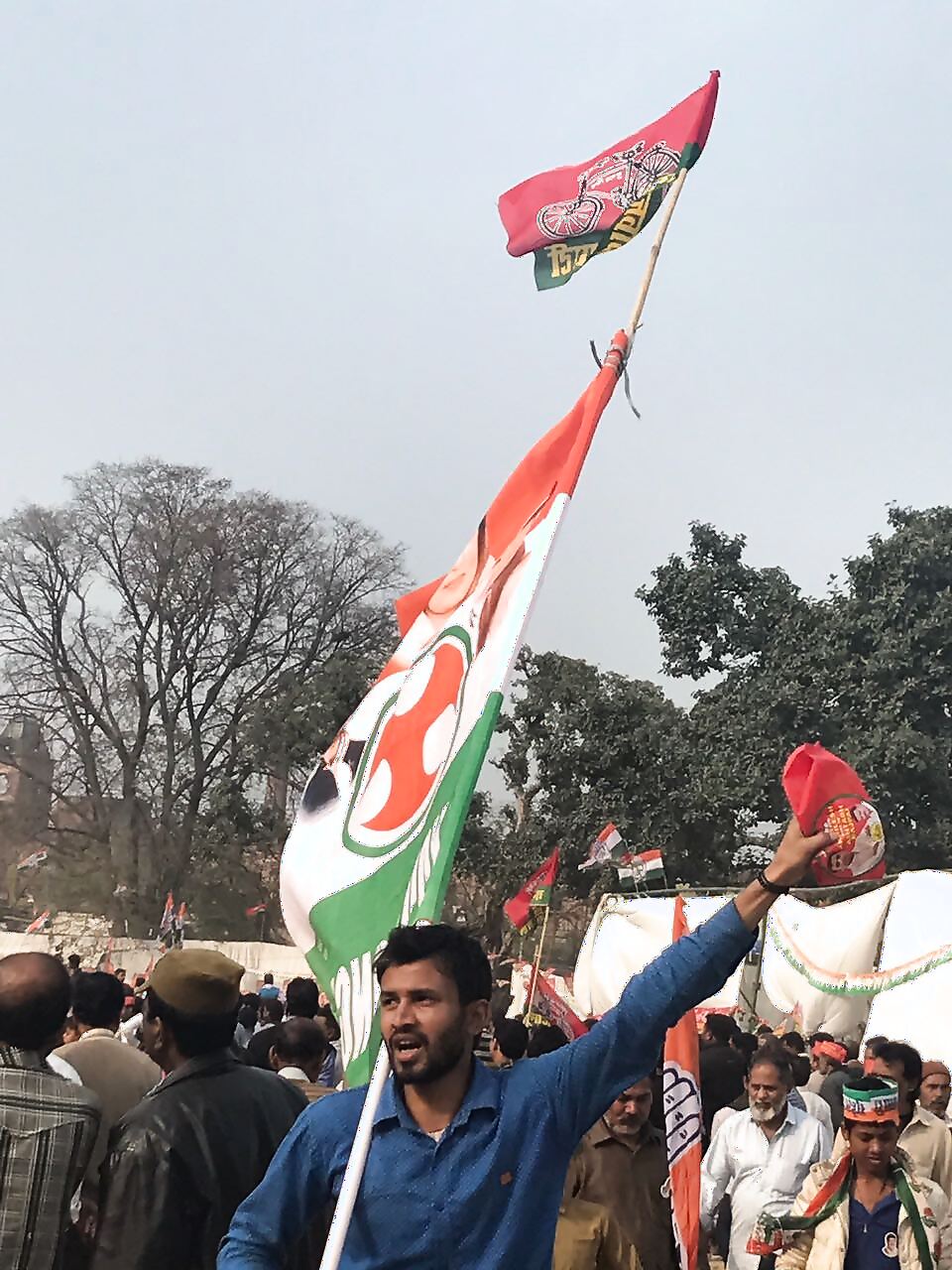
views
New Delhi/Lucknow: Well begun, they say, is half done. The Samajwadi Party-Congress alliance in Uttar Pradesh began quite well with the two ‘UP ke ladke’ — Chief Minister Akhilesh Yadav and Congress Vice-President Rahul Gandhi — both clad in white kurta and black jacket making their joint public appearance in Taj Hotel, Lucknow on January 29, 2017.
But two weeks later, the alliance is exactly at where it began: Half-done.
“Friendly fights” — a euphemism for SP and Congress putting up candidates in the same constituency — continues to be a worry, and neither of “UP’s boys” are being able to rein in their respective parties. SP patriarch Mulayam has refused to campaign for alliance candidates, his sole appearance so far has been for his brother Shivpal Yadav, who is estranged from Akhilesh. And Priyanka Gandhi, perhaps the biggest crowd puller for Congress, has postponed her campaign in the family pocket boroughs of Rae Bareli and Amethi, because of the “friendly fights”.FULL COVERAGE: Assembly Elections 2017
So just why is a promising alliance that has the social equations firmly on its side struggling to take off from the ground?
News18 spoke to a number of people on the ground, including leaders from the SP and the Congress, the candidates fielded by these parties, and the strategists working behind the scenes.
All of them swear there is no lack of chemistry between Akhilesh and Rahul. But both are struggling to shed legacy burdens and are up against walls unique to their parties.
Insiders point out that the alliance isn’t really a coming together of two political parties but a political partnership between two individuals. It doesn’t have the endorsement of SP patriarch Mulayam Singh Yadav who has on more than one occasion openly criticised any pre-poll alliance of his party with the Congress. The consummate politician that Yadav is, he has his logic. Since its creation in 1992, the SP has always fought elections alone. An old Mulayam loyalist told News18 how the wily Hindi heartland politician feels that a pre-poll alliance could only come at SP’s cost. “Party ka jhanda girta hai (our flag goes down),” this leader remembered Mulayam as saying.
“He has given oxygen to a dead Congress at the cost of annihilating ourselves, which would boomerang in the long term for SP,” this leader said.
And then there is the little thing about the political cunning of the Akhilesh-Rahul duo. Among the backroom boys, there are many who point out that the seeds of discord were evident from the first press conference on January 29.
At that press conference, the two ‘UP ke ladke’ appeared in sync with each other, showering praises on each other, hugging, smiling and talking about how they exchange messages and made a perfect made-for-each-other picture. The optics couldn’t have been better until they started taking questions from the media. Rahul Gandhi sounded impatient and angry while Akhilesh Yadav appeared unruffled. When questions were asked about whatever happened to the ‘27 saal behaal’ plank (the slogan with which the Congress started its campaign to show how UP has been, in its view, destroyed by successive SP and BSP governments that ruled the state for 27 years after dislodging the Congress), Rahul didn’t hesitate in playing down the achievements during the SP tenure. He said Akhilesh may have worked, but he hasn’t really delivered on all counts. The young Chief Minister, whose campaign pitch has been ‘kaam bolta hai’ (My work speaks for itself), was quick to defend this rebuffing of his track record.
Besides, there is no shortage of political analysts who feel the alliance would have worked better if Congress President Sonia Gandhi and Mulayam were on board. On the side of the Congress, the alliance architects were Priyanka Gandhi and Prashant Kishor, with little involvement of Sonia. Congress leaders would contend that given the historical animosity between Sonia and Mulayam, thanks to Mulayam famously ditching the Congress president at the last hour in 1999, bringing them on board would be a difficult task.
While it was Kishor who brought both the SP-Congress and the JD(U)-RJD together, the Nitish-Lalu duo had realised the necessity to sink differences by themselves. The anecdotal story is that Nitish called up Lalu as the results for 2014 General Elections started coming in indicating a Narendra Modi sweep, and discussed how they should hold on to their forts.
A source privy to this call told News18 that Nitish expressed concerns that Lalu Yadav's wife Rabri Devi and daughter Misa Bharti both had lost. The two talked about how RJD-JD(U) combined vote share was more than the BJP’s and that the picture would have been different if they had fought the 2014 polls together. That ice-breaker of a phone call made them come together in the by-elections where the alliance showcased their might winning six out of 10 seats. So, when the seat sharing talks began for the Mahagatbandhan in 2015 it went along smoothly. Yes, it helped a lot that both Nitish and Lalu were essentially running one-man shows. Every decision regarding the Mahagatbandhan — its working, common agenda and campaigning — rested solely with them alone not with anyone else.
On the other side, Akhilesh Yadav is on a balancing act since as he has got hold of the party machinery only after the polls were declared, thanks to the family feud that continued for two months. This, SP sources say, has made him cautious, and he is wary of upsetting too many apple carts within.
Sources say Rahul Gandhi may have dismissed their mutual disagreements as operational, but it’s making the day-to-day working of the alliance difficult. With a plethora of opinions and points of view, and a battery of second and third rung leaders, the decision making is slow and time is an essence in any election.
“Jhande mil gaye hain, magar dil nahin mile (The flags are flying united, but minds are not),” Momin, a 25-year-old SP supporter, summed it up neatly.

This reporter ran into Momin at Kidwai Nagar in Kanpur where Akhilesh and Rahul were about to address a joint rally.
An SP leader close to Akhilesh told News18 that the feeling inside the party remains that SP is carrying the burden of Congress. So just why has his leader handed over Congress 105 seats on a platter? Akhilesh had agreed in-principle, so he gave Congress a long rope, the SP leader shrugs.
The two sides may have put up huge posters, plastered the landscape of Uttar Pradesh with the two leaders smiling – UP ko ye saath pasand hai (UP likes this friendship). For Prashant Kishor, hoping to score a hattrick after his success with the Modi campaign in 2014 and the Mahagatbandhan in 2015, this one looks like an altogether new cup of tea. Can he manage the messengers along with the message? Can he build synergies, coherence and bring a disjointed campaign under a single umbrella with time running out?



















Comments
0 comment